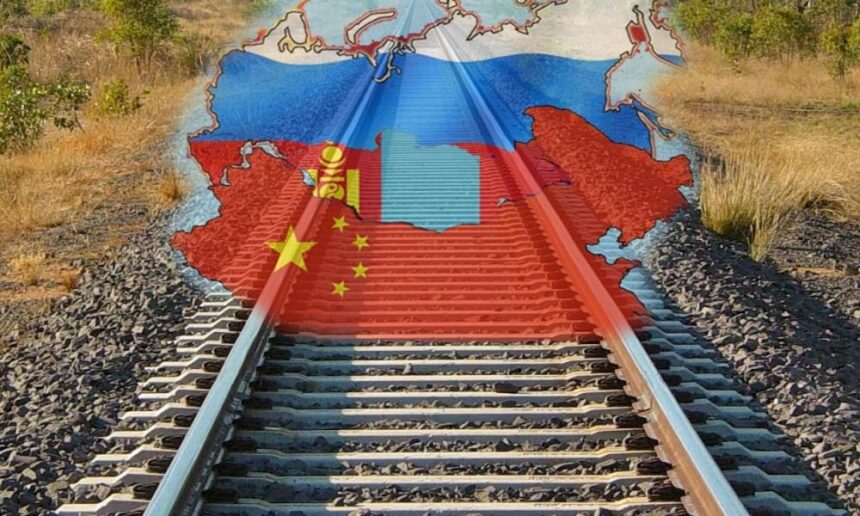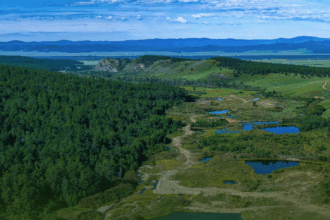Since choosing the path of democracy and a market economy, we have built an economy dominated by the extractive industry and our minerals such as coal, copper, gold and iron ore have been exported mostly to a single country.
It is said that an industrial park will be established soon and will start producing steel and cement, which is expected to not only satisfy domestic needs but also be exported to foreign markets. The electric power required for extracting and processing our natural resources will be supplied from several coal power plants to be built. In order to commence all these projects, which require a great amount of funding as well as work to do, it is absolutely mandatory to build a railroad. However, a final decision on what gauge and what route the railroad to transport extracted minerals from Tavan Tolgoi and Oyu Tolgoi deposits will have has still not been made. It makes us question whether the Government of Mongolia actually has geopolitical and geoeconomic policies.
If such policies exist, how come our government cannot decide what size the gauge of the new railroad to be built in Mongolia will have? Is it going to be the broad gauge the Russians use, or the narrow gauge China has (the standard gauge), or both? Which option can bring optimal efficiency, minimal cost and the least risk to our development projects?
COST MANAGEMENT
Our neighbor in the south is the only purchaser of our mineral products. On the other hand, our northern neighbor supplies their minerals to China (just like we do) and other countries. In order to export our mineral products faster and more efficiently, we need to build a railroad. It will be cheaper if the railroad employs the same gauge used by the buyer.
If we build our new railroad using the broad gauge Russia does, we will need to transship the coal at the Chinese border so that it can be shipped on narrow gauge. Transshipping one ton of coal costs three US dollars, meaning there will be an additional annual cost of 150 million USD if we export 50 million tons of coal a year. Also, coal transshipment greatly pollutes the air and environment. Therefore, some Mongolians prefer to build a narrow gauge railroad to the southern border.
There is another point of view that says it is geopolitically the best option to build on the existing railroad system that employs broad gauge. The third standpoint is that Mongolia must take advantage of its geographical location and become a major hub that will eventually connect two of the world’s biggest railroad networks. It is to be accomplished by having a mixed-gauge railroad that is connected to both the 88,000 kilometer-long broad gauge railroad network of Russia and the 70,000 kilometer-long narrow gauge network that belongs to China.
Furthermore, they say that by building a fast and cheap transit route that connects Asia and Europe and allows natural resources from Russia to be shipped to other Asian countries, Mongolia can create the next Panama Canal and earn a great amount of income by collecting payments for providing transshipment service.
RISK MANAGEMENT
Some Mongolians always talk cautiously about the risk of being too dependent on a single market. Obviously, a business with a single buyer faces many risks, such as the buyer trying to reduce and halt their purchase to decrease prices. It is also risky to increase the prices of transit shipment since it allows the railroads to work.
Those who are in favor of building a narrow gauge railroad from Tavan Tolgoi coal deposit through Oyu Tolgoi are suggesting that specific conditions need to be agreed upon with the Chinese beforehand. What they propose, is that before making the decision on which gauge to use on the new railroad, an amendment has to be made to the 1955 Mongolia-China dialogue on border railroad to establish four new international gateways. They also say that certain ports at Bohai Sea should be included in the Agreement on the Access to and from the Sea and Transport by Mongolia through Chinese territory.
Furthermore, they insist that preceding conditions must be met by China to allow Mongolia to trade with other countries through the Chinese railroad network, which could start with Kazakhstan to the west.
Another group of people support building a broad gauge railroad to the east of Tavan Tolgoi as agreed with Russia, which will allow connection with Tsagaan Suvarga, Sainshand, Baruun-Urt, Choibalsan, and eventually a seaport through Russian territory. According to them, it is an option that will reduce dependency on a single market by allowing quick shipment of goods to both the north and the south.
Others are more in favor of an option that integrates the two options mentioned above. They propose to build a broad gauge railway to the east of Tavan Tolgoi in order to supply coal to steel plants and construct a narrow gauge railroad to the south to supply end users in China and other countries.
When developing our railroad network, we need to get rid of the monopoly and introduce a regulation that separates the ownership and operation of the trains and the tracks. In the future, railroad companies need to be privatized through the stock exchange and up to 40 percent of their ownership should belong to the public. It will increase efficiency through improved management.
The railroad to the south should be built with investment from China. It should have in-kind repayment conditions where the Chinese could be repaid through the cost of shipment. When making such an arrangement, it can be agreed to apply international rates.
The government does not need to acquire loans to fund these projects. Some say that a policy must be adopted that infrastructure investment is made through concession.
POLICY REACH
The time has come for Mongolia to hold a trilateral meeting in order to have a clear, common understanding of “the rules of the game” among all stakeholders about using and expanding the railroad that goes through Mongolia to neighboring countries. We must maintain optimal, equal and balanced relationships with each of our neighboring nations because we are a landlocked country bordering only two other countries.
Also, efficient railroad transportation that transits through Mongolia is in the interests of our “third neighbors”. Therefore, would not it be the right call to engage them as well? How about the Government of Mongolia holds trilateral and multilateral meetings and discussions?
The public currently does not know anything about such meetings – which specialists are having these discussions and what results have been produced. These discussions need to be taken seriously and make it clear what we want, and what they can and cannot do. We can determine the dimensions of gauges afterwards, can’t we?
Such discussions and dialogue could also involve other development projects, such as roads and industrial parks. That way, we can reach many decisions that are mutually beneficial to stakeholders. It will also be more efficient when these development projects are discussed as a whole. If we singlehandedly decide on the gauge dimension without holding multilateral consultations and then force others to accept it, it will just be another impatient, reckless step. We cannot be as directionless and visionless as tumbleweed blowing in the wind.
The Government of Mongolia has been attempting to make amendments and changes after establishing huge agreements that lacked professional capacity and sufficient research. As a result, their partners have been losing trust in them. Furthermore, our government is announcing a competition to promptly allocate the huge loans they acquired without any calculation or designated use. Once again, it makes us question if the government has consistent policy and discipline.
Selling our nonrenewable resources should serve the purpose of creating an economy that is based on knowledge – a renewable resource. In order to achieve this goal, the profit we receive from our mining industry must be high. Our economy will not develop unless we implement these projects that need tens of billions of dollars. However, the most important question is whether we can diversify our economy and improve the livelihoods of people by using the profit created by the mining sector.
Dimensions for geopolitical and geoeconomic policies have to be set before the gauge dimension is determined.
2013.12.11












